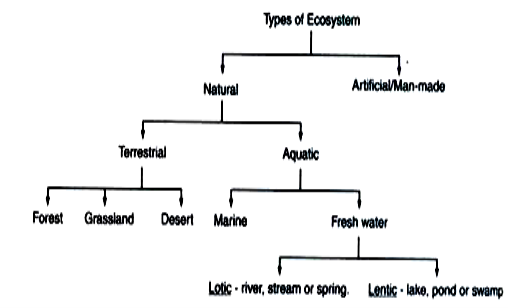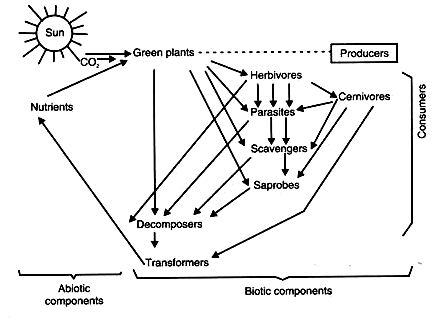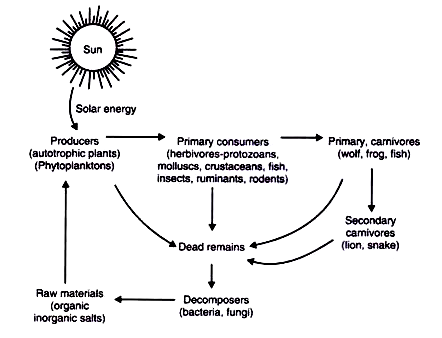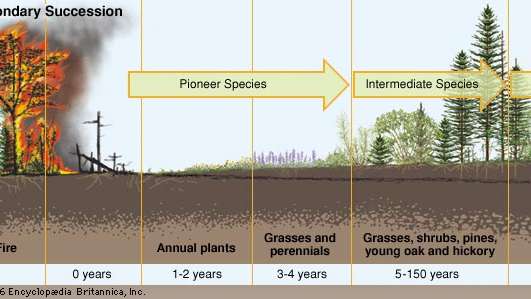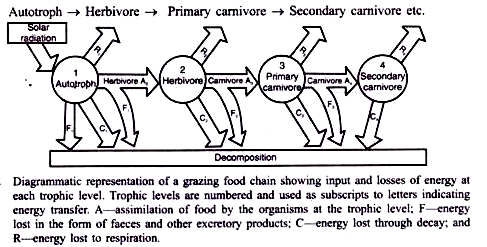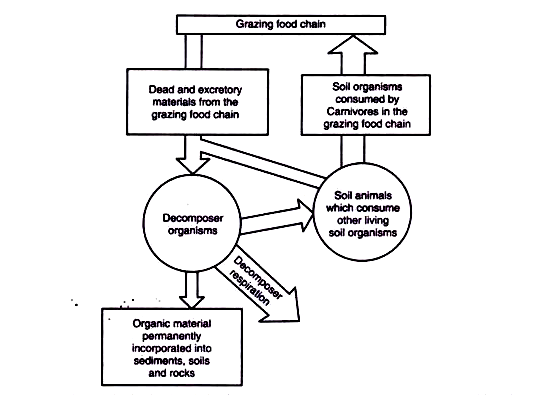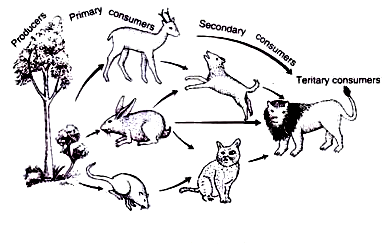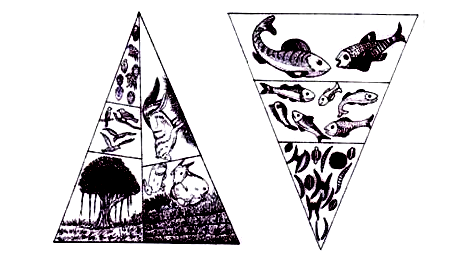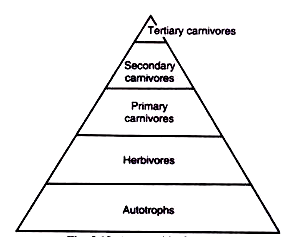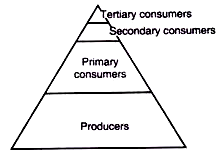UNIT-2
ECOSYSTEMS
The term ecosystem was coined in 1935 by the Oxford ecologist Arthur Tansley to encompass the interactions among biotic and abiotic components of the environment at a given site. The living and non-living components which make up an ecosystem are known as biotic and abiotic components, respectively.
The ecosystem was defined in its presently accepted form by Eugene Odum as, “a unit that includes all the organisms, i.e., the community in a given area interacting with the physical environment so that a flow of energy leads to clearly defined trophic structure, biotic diversity, and material cycles, i.e., exchange of materials between living and non-living, within the system”.
Smith (1966) has summarized common characteristics of most of the ecosystems as follows:
1. The ecosystem is considered a major structural and functional unit of ecology.
2. The structure of an ecosystem is related to its species diversity in the sense that a complex ecosystem has high species diversity.
3. The function of an ecosystem is related to energy flow and material cycles within and outside the system.
4. The relative amount of energy required to maintain an ecosystem depends on its structure. Complex ecosystems need less energy to maintain themselves.
5. Young ecosystems develop and change from less complex to more complex ecosystems, through the process called succession.
6. Each ecosystem has its energy budget, which cannot be exceeded.
7. Adaptation to local environmental conditions is an important feature of the biotic components of an ecosystem, failing which they might get perished.
8. The function of every ecosystem involves a series of cycles, e.g., water cycle, nitrogen cycle, oxygen cycle, etc. These cycles are run on energy. A continuation of the existence of an ecosystem requires the exchange of materials/nutrients to and from the different components.
We can classify ecosystems as follows:
(a) Natural Ecosystems:
These ecosystems have the capability of operating and maintaining themselves without any major interference by man.
A classification based on their habitat can further be made:
1. Terrestrial ecosystems: forest, grassland, and desert.
2. Aquatic ecosystems: freshwater ecosystem, viz. pond, lake, river, and marine ecosystems, viz. ocean, sea, or estuary.
(b) Artificial Ecosystem:
These are maintained by man. These ecosystems are manipulated by humans for different purposes, e.g., croplands, artificial lakes and reservoirs, townships, and cities.
Every ecosystem has non-living (abiotic) and living (biotic) components.
Abiotic Components:
Basic inorganic compounds of an organism, habitat, or an area that are involved in the material cycles are collectively called abiotic components. They include carbon dioxide, water, nitrogen, calcium, phosphorus, etc. The amount of these inorganic substances present in an ecosystem at any given time are known as the standing state or standing quality of an ecosystem.
Whereas, organic components e.g., proteins, amino acids, carbohydrates, and lipids that are synthesized by the biotic counterpart of an ecosystem make the biochemical structure of the ecosystem. The physical environment, viz. climatic and weather conditions are also included in the abiotic structure of the ecosystem.
Biotic Components:
From the trophic (nutritional) point of view, an ecosystem has autotrophic (self-nourishing) and heterotrophic (other nourishing) components.
(a) Autotrophic component (Producers):
This component mainly comprises green plants, algae, and all photosynthetic organisms. Chemosynthetic bacteria, photosynthetic bacteria, algae, grasses, mosses, shrubs, herbs, and trees manufacture food from simple inorganic substances by fixing energy and are therefore called producers.
(b) Heterotrophic component (Consumers):
The members of this component cannot make their food. They consume the matter built by the producers and are therefore called consumers. They may be herbivores, carnivores, or omnivores. Herbivores are called primary consumers whereas carnivores and omnivores are called secondary consumers. Collectively we can call them macro-consumers.
(c) Decomposers:
Heterotrophic organisms are chiefly bacteria and fungi that breakdown the complex compounds of dead protoplasm, absorb some of the products, and release simple substances usable by the producers are called decomposers or reducers. Collectively we call them micro-consumers.
An ecosystem is a functional, structural, and life-sustaining environmental system. The environmental system consists of biotic and abiotic components in a habitat. The biotic component of the ecosystem includes the living organisms; plants, animals, and microbes whereas the abiotic components include inorganic matter and energy.
Abiotic components provide the matrix for the synthesis and perpetuation of organic components (protoplasm). The synthesis and perpetuation processes involve energy exchange and this energy comes from the sun in the form of light or solar energy.
Thus, in any ecosystem we have the following functional components:
(i) Inorganic constituents (air, water, and mineral salts)
(ii) Organisms (plants, animals, and microbes), and
(iii) Energy input which enters from outside (the sun).
The three functional components of the ecosystem interact and form an environmental system. Inorganic components are synthesized into organic structures by the green plants in the habitat (primary producers) through photosynthesis and solar energy is utilized in the process. Green plants become the source of energy for renewals (herbivores) which, in turn, become a source of energy for the flesh eating-animals (carnivores). Animals of all types grow and add organic matter to their body weight and their source of energy is complex organic compounds taken as food.
They are known as secondary producers. All the living organisms, may they be plants or animals have a definite life span after which they die. The dead organic remains of plants and animals provide food for saprophytic microbes, such as bacteria, fungi, and many other animals. The saprobes ultimately decompose the organic structure and break the complex molecules and liberate the inorganic components into their environment.
These organisms are known as decomposers. During the process of decomposition of organic molecules, the energy which keeps the inorganic components bound together in the form of organic molecules gets liberated and dissipated into the environment in the form of heat energy. Thus, in an ecosystem, energy from the sun, the input is fixed by plants and transferred to animal components.
In this process, first, nutrients are withdrawn from the substrate and deposited in the tissues of the plants and animals. They are then cycled from one feeding group to another, released by decomposition to the soil, water, and air, and then recycled. The ecosystems that operate in different habitats like deserts, forests, grasslands, and seas, are interdependent on one another. The energy and nutrients of one ecosystem may be carried into another so that ultimately all parts of the earth get interrelated, each comprising a part of the total system that keeps the biosphere functioning.
Thus, the principal steps in the operation of an ecosystem are as follows:
(1) Reception of radiant energy of the sun,
(2) Producers manufacturing organic materials from inorganic ones,
(3) Consumption of producers by consumers.
(4) After the death of producers and consumers, complex organic compounds are degraded and finally converted by decomposers and converters into such forms as are suitable for re-utilization by producers.
The principal steps in the operation of the ecosystem not only involve the production, growth, and death of living components but also influence the abiotic aspects of the habitat. It is now clear that there is a transfer of both energy and nutrients from producers to consumers and finally to decomposers and transformers levels. In this transfer, there is a progressive decrease of energy but the nutrient component is not diminished and it shows cycling from abiotic to biotic and vice versa.
The flow of energy is unidirectional. The two ecological processes-energy flow and mineral cycling which involve interaction between biotic and abiotic components lie at the heart of ecosystem dynamics. The principal steps and components of an ecosystem are illustrated in the figure.
Key Takeaways:
- An ecosystem can be defined as “a unit that includes all the organisms, i.e., the community in a given area interacting with the physical environment so that a flow of energy leads to clearly defined trophic structure, biotic diversity, and material cycles, i.e., exchange of materials between living and non-living, within the system”.
- Types of ecosystems are Natural and Artificial.
- The ecosystem is composed of two components: Biotic and Abiotic. The functional components are Organic components, Inorganic components, and energy input.
- The principal steps in the operation of an ecosystem are as follows: Reception of radiant energy of the sun, Producers manufacturing organic materials from inorganic ones, and consumption of producers by consumers.
2.5 Energy flow in the ecosystem.
Living organisms can use energy in two forms radiant and fixed energy. Radiant energy is in the form of electromagnetic waves, such as light. Fixed energy is potential chemical energy bound in various organic substances that can be broken down to release their energy content.
Organisms that can fix radiant energy utilizing inorganic substances to produce organic molecules are called autotrophs. Organisms that cannot obtain energy from abiotic sources but depend on energy-rich organic molecules synthesized by autotrophs are called heterotrophs. Those who obtain energy from living organisms are called consumers and those who obtain energy from dead organisms are called decomposers.
When the light falls on the green surfaces of plants, a part of it gets transformed into chemical energy which is stored in various organic products in the plants. When the herbivores consume plants as their food and convert the chemical energy accumulated in plant products into kinetic energy, degradation of energy will occur through its conversion into heat. When herbivores are consumed by carnivores of the first order (secondary consumers), further degradation will occur. Similarly, when primary carnivores are consumed by top carnivores, again energy gets degraded.
Ecological succession is the process by which the structure of a biological community evolves. Two types of succession i.e. primary and secondary, have been distinguished. Primary succession occurs in essentially lifeless areas—regions in which the soil is incapable of sustaining life as a result of such factors as lava flows, newly formed dunes, or rocks left from a retreating glacier. Secondary succession occurs in areas where a community that previously existed has been removed; it is classified by smaller-scale disturbances that do not remove all life and nutrients from the environment.
Primary succession starts in barren areas, such as on bare rock exposed by a retreating glacier. The first inhabitants are lichens or plants—those that can survive in such barren areas. For centuries, these “pioneer species” break down the rock into the soil that can support simple plants such as grasses. These grasses further modify the soil, which is then colonized by other types of plants. Each successive stage changes the habitat by altering the amount of shade and the composition of the soil. The final stage of succession is a climax community, which is a very stable stage that can survive for hundreds of years.
Primary and secondary succession both create a continually changing mix of species within communities as disturbances of various intensities, sizes, and frequencies keep changing the area. The progression of species during succession, however, is not random. At every stage, certain species have evolved life histories to exploit the particular conditions of the community. This situation imposes a partially predictable sequence of change in the species composition of communities during succession. In the initial period, only a small number of species from surrounding habitats can thrive in a disturbed habitat. As new plant species spring out, they modify the habitat by altering such things as the amount of shade on the ground or the mineral composition of the soil. These changes allow other species that are more suitable for this modified habitat to succeed the old species. These newer species are superseded, in turn, by still newer species. A similar succession cycle of animal species keeps going, and interactions between plants, animals, and the environment influence the pattern and rate of successional change.
Secondary succession follows a major disturbance, such as a fire or a flood. The stages of secondary succession are quite similar to those of primary succession; however, primary succession always begins on a barren surface, whereas secondary succession begins in environments that have soil. Also, through a process called old-field succession, farmland that has been abandoned may undergo secondary succession.
In some environments, succession reaches a climax, which gives rise to a stable community dominated by a small number of prominent species. This achieved state of equilibrium, known as the climax community, which is thought to result when the web of biotic interactions becomes so intricate that no other species can enter. In other environments, continual small-scale disturbances produce communities that are a diverse mix of species, and any species may become dominant.
Key Takeaways:
- Ecological succession is the process by which the structure of a biological community evolves. Two types of succession i.e. primary and secondary, have been distinguished.
- Primary succession starts in barren areas, such as on bare rock exposed by a retreating glacier. The final stage of succession is a climax community, which is a very stable stage that can survive for hundreds of years.
- Secondary succession begins in environments that have soil. Farmland that has been abandoned may undergo secondary succession through a process called old-field succession.
In the ecosystem, green plants alone can trap solar energy and convert it into chemical energy. The chemical energy is locked up in the various organic compounds, such as carbohydrates, fats, and proteins, present in the green plants. Since virtually all other living organisms depend upon green plants for their energy, the efficiency of plants in any given area in capturing solar energy is the reason for long-term energy flow and biological activity in the community.
The food manufactured by the green plants is utilized by themselves and also by herbivores. Animals feed repeatedly. Herbivores fall prey to some carnivorous animals. In this way, one form of life supports the other form. Thus, food from one trophic level reaches the other trophic level and a chain is established. This is known as the food chain.
A food chain can be defined as the transfer of energy and nutrients through a succession of organisms through a continuous and repeated process of eating and being eaten. In the food chain, the initial link is a green plant or producer which produces chemical energy available to consumers. For example, marsh grass is consumed by grasshopper, the grasshopper is consumed by a bird and that bird is consumed by a hawk.
Thus, a food chain is formed which can be written as follows:
Marsh grass → grasshopper → bird → hawk
The food chain in any ecosystem runs directly in which green plants are eaten by herbivores, herbivores are eaten by carnivores, and carnivores are eaten by top carnivores. Man forms the terrestrial links of many food chains.
Food chains are of three types:
1. Grazing food chain
2. Parasitic food chain
3. Saprophytic or detritus food chain
1. Grazing food chain:
The grazing food chain starts from green plants and autotrophs it goes from herbivores (primary consumers) to primary carnivores (secondary consumers) and then to secondary carnivores (tertiary consumers) and so on. The gross production of a green plant in an ecosystem may meet three fates—it may get oxidized in respiration, it may be eaten by herbivorous animals and after the death and decay of producers it may be consumed by decomposers and converters and finally released into the environment. In herbivores, the assimilated food can be stored in the form of carbohydrates, proteins, and fats, and later transformed into much more complex organic molecules.
The energy for these transformations is supplied through respiration. As in autotrophs, the energy in herbivores also meets three routes respiration, the decay of organic matter by microbes, and consumption by the carnivores. Similarly, when the secondary carnivores or tertiary consumers eat primary carnivores, the total energy digested by primary carnivores or gross tertiary production follows the same course, and its positioning in the sequence of respiration, decay, and further consumption by other carnivores is entirely similar to that of herbivores.
Thus, it is obvious that much of the energy flow in the grazing food chain can be described in terms of trophic levels as outlined below:
A schematic representation of the grazing food chain showing input and losses of energy has been presented in the figure above.
2. Parasitic food chain:
It goes from large organisms to smaller ones without outright killing as in the case of a predator.
3. Detritus food chain:
The dead organic remains including metabolic wastes and exudates derived from the grazing food chain are generally termed detritus. The energy contained in detritus is not lost in the ecosystem as a whole, rather it serves as a source of energy for a group of organisms called detritivores that are separate from the grazing food chain. The food chain so formed is called the detritus food chain.
Detritus food chain
In some ecosystems, more energy flows through the detritus food chain than through the grazing food chain. In the detritus food chain, the energy flow remains as a continuous passage rather than as a stepwise flow between discrete entities. The organisms in the detritus food chain are many and include algae, fungi, bacteria, slime moulds, actinomycetes, protozoa, etc. Detritus organisms ingest pieces of partially decomposed organic matter, digest them partially and after extracting some of the chemical energy in the food to run their metabolism, excrete the remainder in the form of simpler organic molecules.
The waste from one organism can be immediately utilized by a second one which repeats the process. Gradually, the complex organic molecules present in the organic wastes or dead tissues are broken down into much simpler compounds, sometimes to carbon dioxide and water and all that is left are humus. In a normal environment, the humus is quite stable and forms an essential part of the soil. A schematic representation of the detritus food chain is given as shown in the above figure.
Food web:
Many food chains exist in an ecosystem, but these food chains are not independent. In the ecosystem, one organism does not depend wholly on another. The resources are shared especially at the beginning of the chain. The marsh plants are eaten by a variety of insects, birds, mammals, and fishes, and some of the animals are eaten by several predators.
Similarly, in the food chain grass → mouse → snakes → owls, sometimes mice are not eaten by snakes but directly by owls. This type of interrelationship interlinks the individuals of the whole community. In this way, food chains become interlinked. A complex relationship of interrelated food chains makes up a food web. The Food web is responsible for maintaining the stability of the ecosystem. The higher the number of alternative pathways, the more stable is the community of living things.
Food web in an ecosystem
Ecological pyramid:
The trophic structure of an ecosystem can be indicated using an ecological pyramid. At every step in the food chain, a considerable fraction of the potential energy is lost in the form of heat. As a result, organisms in each trophic level pass on lesser energy to the next trophic level than they receive. This limits the number of steps in any food chain to 4 or 5. The longer the food chain the lesser energy is available for final members. Because of this tapering off of available energy in the food chain, a pyramid is formed that is known as an ecological pyramid. The higher the steps in the ecological pyramid the lower will be the number of individuals and the larger their size.
The idea of ecological pyramids was advanced by C.E. Elton (1927). There are different types of ecological pyramids. In each ecological pyramid, the producer level forms the base and successive levels make up the apex. Three types of pyramidal relations may be found among the organisms at different levels in the ecosystem.
These are as follows:
1. Pyramid of numbers,
2. Pyramid of biomass (the weight of living organisms is known as biomass), and
3. Pyramid of energy.
1. Pyramid of numbers:
It depicts the numbers of individuals in producers and different orders of consumers in an ecosystem. The base of the pyramid is represented by producers which are the most abundant. In the sequence of consumers, the number of organisms goes on decreasing rapidly until there are a few carnivores.
The pyramid of numbers of an ecosystem shows that the producers are consumed in large numbers by smaller numbers of primary consumers. These primary consumers are eaten by a relatively smaller number of secondary consumers and these secondary consumers, in turn, are consumed by only a few tertiary consumers.
This type of pyramid can be best shown by way of an example of Lake Ecosystem. In this type of pyramid, the base trophic level is occupied by producer elements—algae, diatoms, and other hydrophytes which are most abundant. At the second trophic level are the herbivores or zooplanktons which are lesser in number than producers.
The third trophic level is occupied by carnivores which are still smaller in number than the herbivores and the top is occupied by a few top carnivores. Thus, in the ecological pyramid of numbers, there is a relative reduction in the number of organisms and an increase in the size of the body from the base to the apex of the pyramid. In a parasitic food chain starting from the tree, the pyramid of numbers will be inverted.
2. Pyramid of the biomass of organisms:
The living weights or biomass of the members of the food chain present at any one time form the pyramid of the biomass of organisms. This shows the total bulk of organisms or fixed energy present at one time by weight or other means of measuring materials. The pyramid of biomass indicates the decrease of biomass in each tropic level from base to apex, e.g., the total biomass of producers is more than the total biomass of the herbivores.
Likewise, the total biomass of secondary consumers will be lesser than that of herbivores and so on. Since some energy and material are lost in each successive link, the total mass supported at each level is cut short by the rate at which the energy is being stored in the level below. This usually gives a sloping pyramid for most of the communities in terrestrial and shallow-water ecosystems. The pyramid of biomass in a pond ecosystem will be inverted as shown in the figure below.
3. Pyramid of energy:
This depicts not only the amount of total energy utilized by the organisms at each trophic level of the food chain but more importantly, the actual role of various organisms in the transfer of energy. At the producer level, the total energy will be much more than the energy at the successive higher trophic level.
Some producer organisms may have small biomass but the total energy they assimilate and pass on to consumers may be greater than that of organisms with much larger biomass. Higher trophic levels are more efficient in energy utilization but a lot of heat is lost in energy transfer. Energy loss by respiration also progressively increases from lower to higher trophic states.
In the energy flow process, two things turn out as obvious. Firstly, there is one way in which energy moves i.e. unidirectional flow of energy. Energy comes in the ecosystem from an outside source i.e. the sun. The energy captured by autotrophs does not return to the sun, the energy that passes from autotrophs to herbivores does not revert back and as it moves progressively through the various trophic levels, it is no longer accessible for the previous levels.
Thus, due to the unidirectional flow of energy, the system would collapse if the supply from the primary source, the sun is cut off. Secondly, there occurs a progressive decrease in energy level at each trophic level which is largely caused by the energy dissipated as heat in metabolic activities.
Key Takeaways:
- A food chain can be defined as the transfer of energy and nutrients through a succession of organisms through a continuous and repeated process of eating and being eaten. Food chains are of three types: Grazing food chain, Parasitic food chain, Saprophytic or detritus food chain.
- A complex relationship of interrelated food chains makes up a food web. The Food web is responsible for maintaining the stability of the ecosystem.
- In the ecological pyramid, the producer level forms the base and successive levels make up the apex. Three types of pyramidal relations may be found among the organisms at different levels in the ecosystem: Pyramid of numbers, Pyramid of biomass (the weight of living organisms is known as biomass), and Pyramid of energy.
An ecosystem is comprised of all the living and non-living things in a specific natural setting. Plants, animals, insects, microorganisms, rocks, soil, water, and sunlight are major components of many ecosystems. All types of ecosystems can be fit into one of two categories: terrestrial or aquatic. Terrestrial ecosystems are land-based, while aquatic ecosystems are water-based. The major types of ecosystems are grasslands, deserts, forests, tundra, freshwater, and marine. The word “biome” may also be used to describe terrestrial ecosystems that extend across a large geographic area, such as tundra. Keep in mind, however, that within any ecosystem, specific features vary widely – for instance, an oceanic ecosystem in the Caribbean Sea will contain vastly different species than an oceanic ecosystem in the Gulf of Alaska. The various classifications of ecosystems are as follows:
a) Forest ecosystem.
b) Grassland ecosystem.
c) Desert ecosystem.
d) Aquatic ecosystem.
a) Forest ecosystem
A forest ecosystem is a functional unit or a system that comprises soil, trees, insects, animals, birds, and man as its interacting units. A forest is a large and complex ecosystem and hence has greater species diversity.
Also, it is much more stable and resistant to detrimental changes as compared to the small ecosystems such as wetlands and grasslands.
A forest ecosystem, similar to any other ecosystem, also comprises abiotic and biotic components. Abiotic components refer to inorganic materials like air, water, and soil. Biotic components include producers, consumers, and decomposers.
These components interact with each other in an ecosystem and thus, this interaction among them makes it self-sustainable.
Structural Features of the Forest Ecosystem
The two main structural features of a forest ecosystem are:
- Species composition: It refers to the identification and enumeration of the plant and animal species of a forest ecosystem.
- Stratification: It refers to the vertical distribution of different species that occupy different levels in the forest ecosystem. Every organism occupies a place in an ecosystem-based on the source of nutrition. For example, in a forest ecosystem, trees occupy the top level, shrubs occupy the second and the herbs and grasses occupy the bottom level.
Components of a Forest Ecosystem
The components of a forest ecosystem are as follows:
Productivity
The basic requirement for any ecosystem to function smoothly and to sustain is the constant input of solar energy. Plants are also the producers in a forest ecosystem.
In a forest ecosystem, productivity is of two types: primary and secondary. Primary productivity means the rate of capture of solar energy or biomass production per unit area over some time by the plants during photosynthesis.
It is further divided into Gross Primary Productivity (GPP) and Net Primary Productivity (NPP). GPP of an ecosystem can be defined as the rate of capture of solar energy or the total production of biomass. However, plants also utilize a significant amount of GPP in respiration.
Thus, NPP is the amount of biomass left after the utilization by plants or the producers. We can hence say that NPP is the amount that is available for consumption to herbivores and decomposers. Secondary productivity means the rate of absorption of food energy by the consumers.
Decomposition
Decomposition is an extremely oxygen-requiring process. In the process of decomposition, the complex organic compounds of detritus are converted into inorganic substances such as carbon dioxide, water, and nutrients by the decomposers.
Detritus is the remains of the dead plant such as leaves, bark, flowers, and also the dead remains of the animals including their faecal matter. The steps involved in the process of decomposition are fragmentation, leaching, catabolism, humification, and mineralization.
In the process of fragmentation, detritivores break down the detritus into smaller particles. In the process of leaching, water-soluble inorganic nutrients descend into the soil and settle as unavailable salts.
Under the process of catabolism, bacterial and fungal enzymes reduce detritus into simpler inorganic substances. Humification and mineralization processes occur during the decomposition of soil and not detritus.
The process of humification leads to the accumulation of humus which decomposes at a very slow rate. In the process of mineralization, the humus gets further degraded by microbes and inorganic nutrients are released.
Energy flow
Energy flows in a single direction. Firstly, plants capture solar energy and then, transfer the food to decomposers. Organisms of different trophic levels are connected for food or energy relationship and thus form a food chain.
Energy Pyramid is always upright because energy flows from one trophic level to the next trophic level and in this process, some energy is always lost as heat at each step.
Nutrient Cycling
Nutrient cycling is the process of storing and moving nutrient elements through the various components of the ecosystem. There are two types of Nutrient cycling, gaseous and sedimentary.
For the Gaseous cycle (i.e. nitrogen, carbon), the atmosphere or hydrosphere is the reservoir whereas for the sedimentary cycle (i.e. phosphorus) Earth’s crust is the reservoir.
The three major forest ecosystems are:
- The Tropical forest ecosystem
- The Temperate forest ecosystem
- The Boreal or Taiga forest ecosystem
However, there exist more specific types of forest ecosystems within these larger regions.
Key Takeaways:
- A forest ecosystem is a functional unit or a system that comprises soil, trees, insects, animals, birds, and man as its interacting units. A forest ecosystem comprises abiotic and biotic components. Abiotic components refer to inorganic materials like air, water, and soil. Biotic components include producers, consumers, and decomposers.
- The components of the forest ecosystem are Productivity, decomposition, energy flow, and nutrient cycling.
- The major types of forest ecosystems are Tropical, Temperate, and Boreal or Taiga.
b) Grassland ecosystem.
Grasslands grow in the area where the moisture in the soil is less. Moreover, the grassland ecosystem contains plants that do not grow much. They remain shorter in height as they do not receive much rainfall.
However, they can survive in areas like these as their roots are deep within the soil. As a result, they can receive moisture from the soil. The vegetation of the grassland ecosystem depends on the amount of precipitation it is receiving from the surroundings.
The different types of grasslands have different types of animal species. These species adapted to the environment of the climate they are living in.
Grassland ecosystem has five types of grasslands:
- Tropical Grasslands
- Temperate Grasslands
- Flooded Grasslands
- Montane Grasslands
- Desert Grassland
Tropical Grasslands are the ones that receive 50 cm to 130 cm rain. They have both rainy and dry days. As a result, they are warm all year round. Moreover, tropical grasslands are also called Savanna. These grasslands contain shrubs and small trees that are dry. The tropical grasslands contain quite short plants which makes it an excellent place for hunting. For example, the African savanna is one of the tropical grasslands. It can be concluded that the tropical grassland is a home for elephants, giraffes, lions, cheetahs, zebras, and other spectacular species.
Temperate grasslands receive rainfall of the range 25 cm and 75 cm. Furthermore, the climate in the temperate grasslands makes it both dormant and growing. Moreover, these grasslands suffer extreme climates. In the cold season, the temperature can reach up to 0 degrees Fahrenheit. While in the summer season it may go up to 90 degrees in some regions. The precipitation in these grasslands is mostly in the form of dew and snow. Some vegetation that grows here are, cacti, sagebrush, perennial grasses, buffalo grass clovers, and wild indigos, etc.
The flooded grasslands are having water all year-round. These grasslands have numerous plants that grow in water. Various water birds migrate to these areas while some are residents of them. The Everglades is the world’s largest flooded grasslands. It features various types of birds, fish, mammals, reptiles, seed-bearing plants, amphibians, etc.
The word Montane means ‘high altitude’. As per the name, these are the grasslands that are high altitude shrublands. These are called high altitude because they are above the tree line level of the ground. The plants found here have a rosette structure, abundant pilosity, and waxy surfaces. The northern Andes contain this type of habitat.
The desert grasslands are the type of grasslands that separates the true desert of the lowlands and the montane grasslands. These grasslands receive very low precipitation. Because of this, these are the hottest and the driest grasslands. These grasslands are mostly scattered as they are dependent on the areas of rainfall. Since the precipitation varies through regions. Therefore, the vegetation of the grasslands also varies. Moreover, various types of animals are present in these grasslands. For instance, reptiles like the prairie rattlesnake, western diamondback, gopher snake are present here. Furthermore, birds like Horned lark, Larkbunting, Meadowlarks, scaled quail are present here.
Structure of Grassland ecosystem.
The structure of the grassland ecosystem consists of biotic and abiotic components. The biotic components are three; producer organisms, consumers, and decomposers. The producer organisms are mainly eating grasses, though a few herbs and shrubs also make up for primary production in the biomass. The consumers in the ecosystem are mainly of three types: the primary consumers which refer to the herbivores that feed on the grasses, for example, the cows and goats, secondary consumers; the carnivores that take in primary consumers for example frogs, snakes, and jackals. There are also the tertiary consumers like the hawks that eat the secondary consumers. The third type of biotic component is the decomposers which include many saprotrophic microorganisms, for example, bacteria, fungi, and Actinomycetes. They attract the decayed bodies of organisms which aid in the process of decomposition, and the nutrients are given out for reuse by the producers. There are also the abiotic components in the ecosystem which are made up of the organic and inorganic compounds which are in the soil and the aerial environment.
Functions of the Grassland Ecosystem
The primary function of an ecosystem is productivity. The producers utilize solar energy and produce complex organic matter with the help of minerals. It provides forage for livestock, protection, and conservation of soil and water resources, furnishing habitat for wildlife, both flora, and fauna, and (contribution to the attractiveness of the landscape. The functional aspects of the Grassland can be studied by two means:
1. Food Chain in an ecosystem: There is an important feature of the ecosystem that one level of an organism serves as food for another level of the organism. A series is formed which is known as Food Chain. In an ecosystem, the food chain does not follow a linear pattern. An organism may feed upon more than one organism in the same food chain or upon organisms of different food chains. Thus, an interconnected food chain system is formed known as a food web.
2. Nutrient cycle in an ecosystem: For any ecosystem to be successful, the constituent materials must move cyclically. The producers (green plants) take up the mineral elements from the soil and air, convert them into an organic form, and after passing through the different trophic levels, are again returned to the soil and air.
Economic importance of Grassland Ecosystem
Grasslands biomes are important to maintain the crop of many domesticated and wild herbivores such as horse, mule, ass, cow, pig, sheep, goat, buffalo, camel, deer, zebra, etc. which provides food, milk, wool, and transportation to man.
Hence, we can say that the Grassland Ecosystem is a mixture of grass, clover, and other leguminous species, dicotyledonous, herbs, and shrubs which contribute to a high degree of preservation.
Key Takeaways:
- Grasslands grow in the area where the moisture in the soil is less. The different types of grasslands have different types of animal species.
- Grassland ecosystem has five types of grasslands: Tropical Grasslands, Temperate Grasslands, Flooded Grasslands, Montane Grasslands, Desert Grassland.
- Grasslands biomes are important to maintain the crop of many domesticated and wild herbivores such as horse, cow, pig, sheep, goat, buffalo, etc. which provide food, milk, wool, and transportation to man.
c) Desert ecosystem
While deserts are dry, they can be found all around the world. While we may think of a desert as a hot, dry piece of land, it can be cold as well. Regardless of the region, any desert is usually cold at night and receives very little rainfall. However, they do produce plants that have adapted to such living conditions.
Several things make up a desert ecosystem. Among those are:
- Structure
- Characteristics
- Animals
The ecosystem is dependent upon the type of desert; temperate deserts are also known as cold deserts or hot or subtropical deserts. Hot deserts and cold deserts have different kinds of ecosystems. However, despite being very different, the two kinds of deserts have a few similarities.
- Similarities of temperate and subtropical deserts:
- Both get fewer than 10 inches of rain annually.
- Dry air is found in both kinds of biomes.
- Both have harsh living conditions that impact people or animals living there.
- Plants have adapted to having less water and harsher temperatures.
- Animals have adapted to the conditions as far as energy, food consumption, and when to get out and be active.
In general, deserts are made up of several abiotic components – including sand, the lack of moisture, and hot temperatures – basically anything that makes up an ecosystem that isn’t alive. However, many biotic factors affect deserts, which include living things, such as plants and animals.
- Abiotic Components
- Climate
- Temperate Deserts
Antarctica is an example of a temperate desert. The temperatures are so cold; they could lead to the death of humans. To survive, the animals that live in these kinds of deserts have adapted over time. The ways they have done this is by adding extra layers of fat or needing less food and energy to survive.
Subtropical Deserts
These deserts are too hot for many plants and animals to handle. The animals who live in these deserts have adapted to having less water. Because it is so hot during the day, they have become nocturnal and get out during the night when it is cooler and easier to manoeuvre without getting overheated.
But, because the nights are cold, they have had to become accustomed to the colder nights. Plants have had to adjust to having less water. Hence, they are sparse and often close to the ground.
Location
Mountains: There are two major factors in the deserts’ creation; mountains’ rain shadows and the large circulation of global winds. As air with moisture content is pushed up the mountain slopes, it cools then drops water on that particular side of the mountain. In the event of larger mountain ranges, very little water makes it to the other side. Therefore, deserts are often found near mountainous areas, such as:
The Caucasus Mountains in Asia, where the Karakum and Kyzyl Kum deserts are;
The Atacama Desert, which is partly caused by the Andes Mountains in Chile;
Parts of California, where the Santa Cruz mountains are;
The Sahara Desert, which is affected by many different mountain ranges.
Wind patterns: Global wind patterns, which are complicated, play a significant role in where deserts are located. Winds that circulate the globe are the result of the difference between warmer equatorial temperatures and the polar temperatures that are cooler. After the air gets warm at the equator, it moves upward.
Then it moves toward the North Pole and toward the South Pole, where it loses moisture, cools off, and then sinks before returning to the equator. Therefore, stable wind patterns and shifting global patterns can be the reason for where a desert is.
The passage of time greatly influences where and how deserts form. As time has passed, the locations of deserts have moved. This change has been the result of the uplifting of mountain ranges and continental drift. The latitudes are where more deserts are situated are known as horse latitudes, which is generally straddling the Tropic of Capricorn and the Tropic of Cancer, which lies between 15 and 30 degrees to the equator’s north.
There are geologically ancient deserts, such as the Sahara Desert in northern Africa, which is 65 million years old, or the Kalahari in central Africa. In North America, three of the four major deserts are within a geological region called the Range Province and the Basin, which falls between the Sierra Nevada and the Rocky Mountains, then extending into the state of Sonora in Mexico.
The forces of erosion shaped the desert landscapes during heavy rainfall over thousands of years. The rocky mountain slopes and hillsides caught the rain, which picked up loose sediment, sand, cobbles, and boulders then moved them. As gravity caused the water to be carried downhill, sediments moved down to the basin along with it. At the bottom of the mountain, the water spread out across a broad area where the mouths of canyons widened.
Temperature
The temperature of a given desert varies due to its geographic location. However, a characteristic of all deserts is dryness. Heat is reflected by water vapor, which is either in the form of cloud cover or humidity, which causes a cooling effect. Because of the reactions and the characteristics, deserts experience extreme temperatures, regardless of whether it is heat or cold.
The temperature fluctuations can result in other effects. Cool air sinks and warm air rises and the fast changes in temperatures cause the air to move fast from one place to another. Therefore, deserts are windy, and those conditions contribute to evaporation.
About 90% of available sunlight is transmitted by clear dry air, which in comparison to a typical humid climate seeing 40% of the available sunlight. The additional sunlight has ultraviolet radiation, which can cause major damage to plants, animals, and people.
Precipitation
The environment in the desert is unpredictable and uneven. And the precipitation that it does receive is minimal. Precipitation amounts can vary from one year to another. Some years it may seem as though the desert has gotten more rainfall than usual, but most of the time, it receives very little rainfall. There can be entire years that the desert doesn’t see a drop of rain.
Biotic Components
Plant Life
Water is a necessity everywhere and for every living thing. It is extremely important in the desert as well. Due to the lack of water, the plants have made major adaptations.
Plant Adaptations
The seeds of annual plants stay dormant until a time when adequate rainfall is received to support a young plant.
Cacti and other succulents store water in their spines, which are residual leaves. The stem is where photosynthesis takes place, and the stem has pleats that can expand fast when rain falls.
Evergreens have cuticles and sunken stomata on shrubs that help them to hold water and prevent it from escaping. For example, the holly plant’s leaves stay at 70-degree angles, so the sun only hits its sides. When the sun sinks low in the sky, the entire leaf is exposed. A fine salt covering forms on the leaves, and that helps reflect the sun off of the plant.
More than a fifth of the earth’s land is comprised of deserts. The lack of water can create a survival problem for any humans, animals, plants, or organisms. Besides the low rainfall, deserts experience a high amount of water loss from evaporation from the ground and through the transpiration of plants.
Evapotranspiration is the combination of evaporation and transpiration. Potential evapotranspiration is the quantity of water that would be lost by transpiration and evaporation if they were possible. Scientists measure this amount under controlled conditions by using a large pan of water.
The soil in the desert is known for its coarseness, which allows the little moisture that is present to pass through quickly, which means it is not available for plants. Salts accumulate as a result of the high evaporation rate. The soil turns alkaline and limits plant growth.
Animal Life
Because of the entire process required to maintain life in the desert, the impact is that the size of individual animals is limited as well as the size of animal populations. The extremes of heat and aridity that result in deserts are some of the most fragile of ecosystems in the world.
People visiting the desert should take proper precautions to protect themselves as the environment is much different than at any other location.
Despite common beliefs that things can’t live in the desert, many creatures have learned to survive on the distinctive plant life and in difficult conditions.
Large mammals like camels make their homes in the desert and are suited to travel long periods without water. Lions live in the deserts of Africa, although they are endangered due to changing weather patterns and the presence of humans.
Small rodents find homes in the desert, with variations from gerbils to hedgehogs. Larger hyenas and jackals are also often found in deserts.
Lizards and snakes are particularly suited to the dry, hot climate of the desert, as are amphibious creatures like some toads and salamanders.
Importance of Desert Ecosystem
The desert biome is very important to this earth. Deserts are found on every single continent, and though they lack water, they play an essential role in helping animals, humans, and the environment.
1. Flora & Fauna
Deserts are home to a variety of unique plants and animals that have adapted to their harsh habitats. They are home to various livestock such as camels, goats, and antelope that provide food and livelihood for people. Desert shrubs and trees that produce fruit such as dates, and figs, and olives are an important food source in North Africa and the Middle East.
Besides adding to the Earth’s biodiversity, many of these plants and animals benefit humans. Domesticated camels in the deserts of Asia and North Africa have been reliable pack animals for thousands of years. If deserts disappear, many insects and animal species will also disappear. Many biotic factors depend on deserts for food, water, and shelter.
2. Mineral Resources
There are 15 types of mineral deposits on our planet, and 13 of them are found in deserts. Some important minerals are formed in the dry condition of deserts. Gypsum, borates, nitrates, potassium, and other salts build up in deserts when water carrying these minerals evaporates. The extraction of important minerals from desert regions has become easier due to less vegetation in the area.
According to United Nations statistics, over 50% of world copper comes from deserts in Mexico, Australia, and Chile. Other minerals and metals such as bauxite, gold, and diamonds are found in large quantities in the deserts of China, the United States, and Namibia. Desert regions also hold 75% of known oil reserves in the world.
3. Carbon Sinks
Scientists discovered that cyanobacteria living in the sands of the Kalahari Desert of Botswana help gather and store carbon dioxide from the air.
These drought-resistant bacteria can fix atmospheric carbon dioxide, and together they add large quantities of organic matter to the nutrient-deficient sand. Since carbon dioxide is one of the prime causes of global warming, these desert sands may play a critical role in preventing additional carbon dioxide from entering the atmosphere.
4. Archaeological Discoveries
Arid conditions are ideal for preserving human artifacts and remains. Present-day archaeologists came to know about ancient civilizations because of the mummified human remains found in countries like Peru, China, and Egypt. In March 2010, the New York Times reported that scientists working in the middle of a terrifying desert, north of Tibet, in western China, discovered a 4,000year-old cemetery of 200 corpses that showed European facial features.
The cemetery is now situated in China’s northwest autonomous region of Xinjiang, yet the people there have European features, with brown hair and long noses. Discoveries like these help in shaping the modern understanding of how our societies first formed.
5. Leisure and Tourism
Deserts attract millions of visitors every year. The deserts of the Middle East and North Africa have the Great Pyramids of Giza in Egypt. Jordan’s city of Petra, Carthage, and others are places that show well-preserved archaeological ruins of the past. In the USA, the Chaco culture, Pueblo peoples such as the Anasazi and Hohokam, lived in the deserts of modern New Mexico, Utah, and Arizona.
The Anasazi houses at Mesa Verde are an incredible sight, as is the Casa Grande monument in Arizona, built by the Hohokam Culture. In South America, there are many sites and artifacts recovered from the Atacama.
6. Bio-Prospecting
Desert plants have adapted such special properties that help them survive in extremely harsh desert climates. According to a UN report on the global outlook of deserts, a recent survey of plants in Israel’s Negev desert found plants that could help fight malaria.
Key Takeaways:
- The things that make up a desert ecosystem are Structure, Characteristics, and animals.
- The conditions in a desert depend on factors such as location, temperature, precipitation. Deserts can be hot as well as cold.
- Deserts are home to a variety of unique plants and animals that have adapted to their harsh habitats. 13 Types of mineral deposits are found in deserts.
d) Aquatic ecosystems.
Water certainly supports many lives. The organisms which survive in water are aquatic organisms. Their survival depends on water. They rely on water for food, shelter, reproduction, and many other life activities.
Definition of Aquatic Ecosystem
An ecosystem is a community of living organisms and their physical and chemical environment which are linked together with the help of flows of energy and nutrients. Ecosystems function as an ecological unit and, therefore, can be defined at a variety of scales.
The aquatic ecosystem includes freshwater habitats such as lakes, ponds, rivers, oceans and streams, wetlands, swamps, etc. On the other hand, marine habitats include oceans, intertidal zone, reefs, seabed, and so on. The aquatic ecosystem is the habitat for water-dependent species like animals, plants, etc
Living organisms in a particular environment get affected by characteristics such as nutrient concentrations, temperature, water flow, and shelter. However, only those organisms can survive which can live in the conditions of a particular habitat and use the available resources.
Interactions between living organisms can also affect the type of organisms that are be found in an aquatic ecosystem. Therefore, the understanding of the basic components of aquatic ecosystems and the related interactions can lead to better management of human impacts on these systems.
Different types of aquatic ecosystems are as follows:
1. Freshwater Ecosystem:
These cover only a small portion of the earth which is nearly 0.8 percent. Freshwater means lakes, ponds, rivers and streams, wetlands, swamps, bogs, and temporary pools.
2. Lotic Ecosystems:
These mainly refer to the rapidly flowing waters that move in a single direction including the rivers and streams. These environments are comprised of numerous species such as beetles, mayflies, stoneflies, and several species of fishes including trout, eel, minnow, etc.
3. Lentic Ecosystems:
They include all standing water habitats. Lakes and ponds are the primary examples of the Lentic Ecosystem. These ecosystems contain species such as algae, crabs, shrimps, and amphibians such as frogs and salamanders.
4. Wetlands:
Wetlands are marshy areas and are sometimes covered in water that supports a wide variety of plants and animals. Swamps, marshes, bogs, black spruce, and water lilies are the main examples of the plant species. The animal life of this ecosystem consists of dragonflies, damselflies, and various birds and fishes.
5. Marine Aquatic Ecosystem:
The marine ecosystem covers the largest surface on the earth. Two-thirds of the earth is covered by water which includes oceans, seas, intertidal zone, reefs, seabed, etc. Each life form is unique and native to its habitat.
6. Ocean Ecosystems:
Our earth is having five major oceans. Moreover, these oceans are like a home to more than five lakhs of aquatic species. Some species of this ecosystem include shellfish, Shark, Tube Worms, Crab Small, and large ocean fishes.
7. Coastal Systems:
These are the open systems of land and water that are combined to form the coastal ecosystems. A wide variety of species of aquatic plants and algae live at the bottom of it. The diverse fauna consists of crabs, fish, insects, lobsters, snails, etc.
Functions
Aquatic ecosystems perform many important environmental functions. For example, they recycle nutrients, perform water purification, attenuate floods, recharge groundwater and provide habitats for wildlife. Aquatic ecosystems are also helpful for human recreation, and are very important to the tourism industry, especially in coastal regions.
The health of an aquatic ecosystem is degraded when the ecosystem's ability to absorb stress has been exceeded. A stress on an aquatic ecosystem can be a result of physical, chemical, or biological alterations to the environment. Physical alterations may include changes in water temperature, water flow, and light availability. Chemical alterations include changes in the loading rates of bio-stimulatory nutrients, oxygen consuming materials, and toxins. Biological alterations include over-harvesting of commercial species and the introduction of exotic species. Human populations can impose excessive stresses on aquatic ecosystems. There are many examples of excessive stress with negative consequences. The environmental history of the Great Lakes of North America illustrates this problem, particularly how multiple stresses, such as water pollution, over-harvesting, and invasive species can combine.
Key Takeaways:
- The aquatic ecosystem includes freshwater habitats such as lakes, ponds, rivers, oceans and streams, wetlands, swamps, etc.
- The various types of aquatic ecosystems are Freshwater, Lotic, Lentic, Wetland, Marine aquatic, Ocean, and Coastal.
- Aquatic ecosystems recycle nutrients, perform water purification, attenuate floods, recharge groundwater and provide habitats for wildlife.
References:
- Textbook Of Environmental Science By Deeksha Dave And E.Sai Baba Reddy, Cengage
- Publications.
- Text Book Of Environmental Sciences And Technology By M.Anji Reddy, Bs Publication.
- Comprehensive Environmental Studies By J.P.Sharma, Laxmi Publications.
- Environmental Sciences And Engineering – J. Glynn Henry And Gary W. Heinke – Prentice Hall Of
- India Private Limited.
- A Text Book Of Environmental Studies By G.R.Chatwal, Himalaya Publishing House
